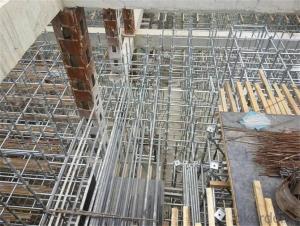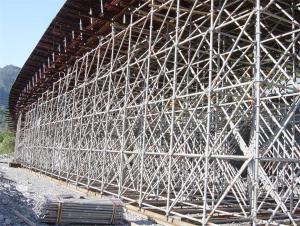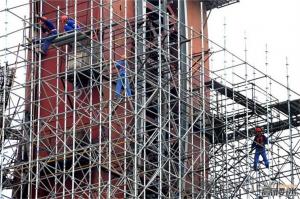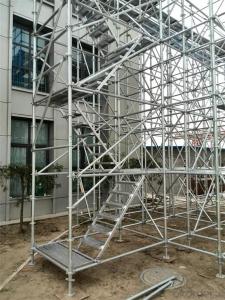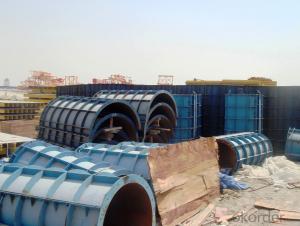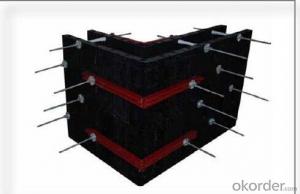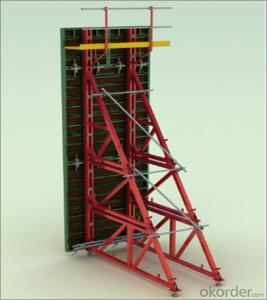RingLock Scaffolding with Cold Galvanized Surface Processing Style
- Loading Port:
- Shanghai
- Payment Terms:
- TT OR LC
- Min Order Qty:
- 1 m²
- Supply Capability:
- 100000 m²/month
OKorder Service Pledge
OKorder Financial Service
You Might Also Like
1.Structure of Ring lock Description
Ringlock Scaffolding system is the most popular used Scaffolding system in the world.It will greatly reduce the cost because of the following advantages
Packaging & Delivery
Packaging Details:
Pallet or bag or upon client's request
Delivery Detail:
35days
2.Main Features of Ringlock
It will greatly reduce the cost because of the following advantages
1)Using less pipes
2)Easy to install
3)It can be used again and again for nearly 20years
3.Ring lock product pictures:
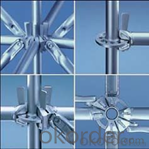
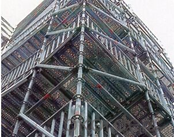
4.Ringlock Product Description
Type: ringlock scaffolding diagonal Brace
specification : Ø48.3×3.20
material:: steel Q235
Finished: Hot DIP galvanized, painted
Diagonal length(m) :Weight(kg)
0.9m * 1.25m 6.28
1.25m * 2.7m 11.45
5.FAQ
We have organized several common questions for our clients,may help you sincerely:
1)How about your company?
CNBM International Corporation, China National Building Materials (Group) Corporation, is one of the largest companies in China building material equipment industry, Our formwork and scaffolding are largely used in both domestic and all over world;
2)How many Scaffolding your company have?
Here comes our 5 types of Scaffolding systems:
- Cup lock Scaffolding(C-Lock Scaffolding)
- Ring lock Scaffolding
-Kwistage Scaffolding
-H-frame Scaffolding
-ID15 Scaffolding Tower, this type Scaffolding is the most widely used in construction, such like bridge.
3)How long can we receive the product after purchase?
Lead time is about 30days after getting the signed PI and deposit.
- Q:Can steel frame formwork be used in areas with limited access to utilities?
- Yes, steel frame formwork can be used in areas with limited access to utilities. Unlike traditional formwork systems that require water and electricity for setup and removal, steel frame formwork is designed to be easily assembled and disassembled without the need for additional utilities. It is a versatile and portable solution that can be used in remote locations or areas where access to utilities is limited. Steel frame formwork is typically lightweight and can be transported to the site manually or with minimal machinery, making it suitable for areas with limited infrastructure. Additionally, steel frame formwork can be reused multiple times, reducing the need for constant supply of utilities during construction. Overall, steel frame formwork provides a practical and efficient solution for construction projects in areas with limited access to utilities.
- Q:Can steel frame formwork be used for complex architectural designs?
- Yes, steel frame formwork can be used for complex architectural designs. Steel frame formwork is a versatile and adaptable system that can be customized to fit various shapes and sizes. It provides the necessary strength and stability to support and mold concrete into complex architectural designs. The steel frames can be easily adjusted and interconnected to create intricate forms, curves, and angles, allowing for the realization of unique and challenging architectural structures. Additionally, steel frame formwork is durable, reusable, and can withstand the pressure and weight of the concrete, making it a suitable choice for complex architectural designs that require precision and stability.
- Q:What is the typical lead time for manufacturing steel frame formwork?
- The typical lead time for manufacturing steel frame formwork can vary depending on several factors such as the complexity of the design, quantity required, availability of raw materials, and the production capacity of the manufacturer. However, on average, the lead time for manufacturing steel frame formwork can range from a few weeks to a few months. It is important to consider that the lead time also includes the time required for design approval, fabrication, quality control, and transportation. Therefore, it is advisable to consult with the specific manufacturer or supplier to get an accurate estimate based on your specific requirements and circumstances.
- Q:Can steel frame formwork be used for both large and small construction projects?
- Indeed, steel frame formwork is suitable for construction projects of both large and small scales. This adaptable and long-lasting solution can easily be tailored to meet the specific requirements and sizes of various projects. By providing a sturdy and secure framework for concrete pouring, it guarantees precision and accuracy in construction. Whether it be a compact residential dwelling or a sprawling commercial complex, steel frame formwork can be adjusted and assembled accordingly to achieve the desired shape and structure. Moreover, its reusability renders it a cost-efficient option for projects of any magnitude. The combination of its versatility, durability, and recyclability establishes it as a fitting choice for construction undertakings of all dimensions.
- Q:What are the different types of finishes that can be achieved using steel frame formwork?
- There are several types of finishes that can be achieved using steel frame formwork, including smooth finishes, textured or patterned finishes, exposed aggregate finishes, and decorative finishes.
- Q:What are the transportation and logistics considerations for steel frame formwork?
- When dealing with steel frame formwork, it is essential to take into account various transportation and logistics factors. Firstly, the weight and dimensions of the steel frames must be considered. Given that steel is a heavy material, the chosen transportation method must be capable of handling the weight. It is crucial to ensure that the vehicle used for transportation, such as trucks or trailers, can safely carry the steel frames and that they can be loaded and unloaded securely. Another factor to consider is the protection of the steel frames during transportation. Since steel is susceptible to corrosion and damage, appropriate packaging and covering should be employed to shield the frames from exposure to the elements. This may involve using plastic or waterproof covers and ensuring that the frames are tightly secured during transportation to prevent any shifting or movement that could cause harm. Furthermore, the logistics of delivering steel frame formwork to the construction site must be carefully planned. Factors such as the distance between the manufacturing facility and the construction site, as well as the chosen route and transportation infrastructure, should all be taken into account. It is essential to carefully strategize the logistics to ensure prompt delivery and minimize any disruptions to the construction schedule. In addition, a well-organized inventory management system for steel frame formwork is crucial. This includes accurately tracking the quantity, condition, and location of the formwork frames to ensure they are readily available when needed and to prevent any delays or inefficiencies in the construction process. In summary, transportation and logistics considerations for steel frame formwork involve addressing the weight and dimensions of the frames, protecting them during transportation, carefully planning the delivery logistics, and implementing an effective inventory management system. By meticulously considering these factors, construction projects can guarantee the smooth and efficient transportation and utilization of steel frame formwork.
- Q:What are the different types of supports and props used with steel frame formwork?
- There are several types of supports and props that are commonly used with steel frame formwork systems. These supports and props play a crucial role in providing stability and support to the formwork, ensuring that the concrete structure is properly formed and maintained during the construction process. Some of the different types of supports and props used with steel frame formwork include: 1. Adjustable Steel Props: These are telescopic steel tubes that can be adjusted to different lengths. They are commonly used to support horizontal formwork elements such as beams and slabs. The adjustable feature allows for easy height adjustment and ensures stability during concrete pouring. 2. Tripod Supports: Tripod supports consist of three legs with adjustable heights. They are used to support vertical formwork elements such as columns and walls. Tripod supports provide stability and are easily adjustable to accommodate different formwork heights. 3. Soldier Props: Soldier props are vertical supports that are commonly used to support vertical formwork elements such as walls. They are typically made of steel and are adjustable in height. Soldier props provide stability and are often used in conjunction with other supports for added reinforcement. 4. Scaffolding: Scaffolding is a temporary structure that is used to support workers and materials during construction. It is often used in conjunction with steel frame formwork systems to provide additional support and access to different areas of the structure. Scaffolding is typically made of steel or aluminum and can be easily assembled and disassembled. 5. Formwork Brackets: Formwork brackets are used to support horizontal formwork elements such as beams and slabs. They are typically attached to the structure using bolts or clamps and provide additional support and stability during concrete pouring. Formwork brackets are often adjustable to accommodate different formwork heights and configurations. 6. Wall Ties: Wall ties are used to hold formwork panels together and provide stability to vertical formwork elements such as walls. They are typically made of steel and are secured to the formwork panels using nuts and bolts. Wall ties ensure that the formwork panels remain in place during concrete pouring and curing. Overall, the different types of supports and props used with steel frame formwork systems are designed to provide stability, support, and flexibility during the construction process. These supports and props are essential in ensuring that the formwork remains in place, allowing for the proper formation of concrete structures.
- Q:Can steel frame formwork be used for both single-story and multi-story construction projects?
- Yes, steel frame formwork can be used for both single-story and multi-story construction projects. The strength and durability of steel make it suitable for supporting concrete structures of varying heights and sizes. Its versatility allows it to be easily adjusted and reassembled, making it a cost-effective solution for different construction projects.
- Q:How does steel frame formwork prevent concrete shrinkage or cracking?
- Steel frame formwork is an effective solution to prevent concrete shrinkage or cracking due to its robust and rigid structure. The steel frames act as a support system that holds the concrete in place during the curing process. This prevents the concrete from moving or shifting, allowing it to dry evenly and reducing the risk of shrinkage or cracking. One of the main advantages of using steel frame formwork is its ability to provide excellent reinforcement and stability to the concrete structure. The steel frames are designed with precise measurements and are securely fixed in place, ensuring that the concrete retains its shape and form while it cures. This eliminates any potential for uneven drying or settlement, which can lead to shrinkage or cracking. Additionally, steel is known for its high tensile strength and durability, making it an ideal material for formwork. The steel frames can withstand the pressure exerted by the wet concrete and prevent it from expanding or contracting excessively as it dries. This stability minimizes the development of internal stresses within the concrete, which are a common cause of shrinkage or cracking. Furthermore, steel frame formwork provides a smooth and seamless surface for the concrete. This prevents the formation of voids or air pockets, which can weaken the concrete structure and increase the likelihood of shrinkage or cracking. The tight fit between the steel frames ensures that the concrete is uniformly distributed and compacted, resulting in a stronger and more resilient finished product. Overall, steel frame formwork plays a crucial role in preventing concrete shrinkage or cracking by providing a stable and supportive structure during the curing process. Its robustness, precise measurements, and ability to withstand pressure ensure that the concrete retains its shape and dries evenly. By eliminating uneven drying, settlement, and internal stresses, steel frame formwork helps to create a high-quality, durable, and crack-free concrete structure.
- Q:Are there any limitations on the height of structures that can be constructed using steel frame formwork?
- The construction of structures using steel frame formwork is subject to certain limitations when it comes to height. The primary factors that influence these limitations include the design, engineering considerations, and the capabilities of the steel frame formwork system being utilized. A crucial aspect that can restrict the height is the capacity of the steel frame formwork to bear loads. It must be capable of supporting the weight of the concrete as well as any additional loads such as construction equipment or workers. Should the height surpass the formwork's load-bearing capacity, it may lead to structural instability and potential collapse. Furthermore, the stability and rigidity of the steel frame formwork system play a vital role in determining the maximum height. As the height increases, the formwork system must withstand lateral forces, wind loads, and other external factors that can impact the structure's stability. Failure to account for these forces in the formwork's design compromises the construction's safety and integrity. In addition, the availability of suitable equipment and technology can impose restrictions on the height of structures constructed using steel frame formwork. Taller structures may necessitate specialized equipment, such as high-capacity cranes or lifting systems, for the assembly and dismantling of the formwork. If such equipment is unavailable or impractical, it limits the height achievable with steel frame formwork. Lastly, local building codes and regulations also dictate the maximum height of structures. These regulations exist to guarantee the safety and stability of buildings and prevent potential risks to the surrounding environment. It is imperative to adhere to these regulations and obtain appropriate permits when constructing tall structures using steel frame formwork. To conclude, while steel frame formwork offers versatility and strength in construction, there are limitations on the height of structures that can be constructed using this system. Factors such as load-bearing capacity, stability, equipment availability, and local regulations determine the maximum achievable height. It is crucial to consult experienced engineers and adhere to safety guidelines to ensure the successful construction of tall structures using steel frame formwork.
1. Manufacturer Overview |
|
|---|---|
| Location | |
| Year Established | |
| Annual Output Value | |
| Main Markets | |
| Company Certifications | |
2. Manufacturer Certificates |
|
|---|---|
| a) Certification Name | |
| Range | |
| Reference | |
| Validity Period | |
3. Manufacturer Capability |
|
|---|---|
| a)Trade Capacity | |
| Nearest Port | |
| Export Percentage | |
| No.of Employees in Trade Department | |
| Language Spoken: | |
| b)Factory Information | |
| Factory Size: | |
| No. of Production Lines | |
| Contract Manufacturing | |
| Product Price Range | |
Send your message to us
RingLock Scaffolding with Cold Galvanized Surface Processing Style
- Loading Port:
- Shanghai
- Payment Terms:
- TT OR LC
- Min Order Qty:
- 1 m²
- Supply Capability:
- 100000 m²/month
OKorder Service Pledge
OKorder Financial Service
Similar products
New products
Hot products
